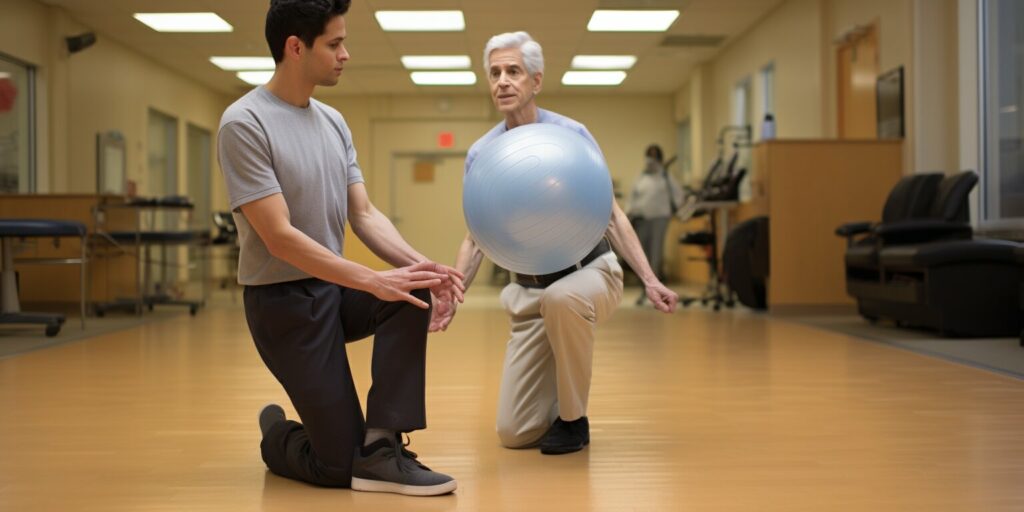Welcome to our comprehensive guide on innovative therapies and treatments for managing movement disorders. Movement disorders are a group of neurological disorders that affect millions of people around the world. Conditions such as Parkinson’s disease, dystonia, essential tremor, Huntington’s disease, Tourette syndrome, restless leg syndrome, and ataxia can significantly impact an individual’s ability to coordinate and control their movements.
In this article, we will explore the latest advancements in the field of movement disorder treatment. From conventional approaches to cutting-edge therapies, we will discuss a wide range of options available to help individuals regain their mobility and enhance their quality of life. Additionally, we will highlight the importance of lifestyle modifications and supportive care in managing these conditions.
Whether you or a loved one are dealing with a movement disorder, it is crucial to stay informed and seek early diagnosis. By understanding the available treatment options and staying abreast of the latest research, individuals with movement disorders can take proactive steps toward achieving an improved quality of life.
Join us as we delve into the world of innovative therapies and treatments, and discover how they can make a positive difference in the lives of those affected by movement disorders.
Understanding Movement Disorders
This section will delve deeper into the different types of movement disorders and their characteristics. Movement disorders are a group of neurological disorders that affect the ability to control and coordinate movements. They can significantly impact the nervous system, leading to difficulties in mobility and impairing the quality of life for affected individuals.
There are various types of movement disorders, each with its own unique set of symptoms and challenges. Some of the most common movement disorders include:
- Parkinson’s disease
- Dystonia
- Essential tremor
- Huntington’s disease
- Tourette syndrome
- Restless Leg Syndrome
- Ataxia
Let’s explore these disorders in more detail:
Parkinson’s Disease
Parkinson’s disease is a progressive disorder characterized by tremors, stiffness, and slow movement. It occurs due to the loss of dopamine-producing cells in the brain, leading to a disturbance in the control of movement.
Dystonia
Dystonia is a neurological condition that causes involuntary muscle contractions, resulting in repetitive and often twisting movements. It can affect various body parts, including the neck, face, and limbs.
Essential Tremor
Essential tremor is a common movement disorder characterized by rhythmic trembling of the hands, head, or other parts of the body. The tremors are typically more noticeable during voluntary movements and can significantly impact daily activities.
Huntington’s Disease
Huntington’s disease is a genetic disorder that affects the brain, causing uncontrolled movements, cognitive decline, and emotional changes. It is caused by a mutation in the huntingtin gene.
Tourette Syndrome
Tourette syndrome is a neurological disorder characterized by repetitive, involuntary movements and vocalizations known as tics. These tics can range from mild to severe and can have a significant impact on social interactions and daily functioning.
Restless Leg Syndrome
Restless Leg Syndrome is a condition characterized by an irresistible urge to move the legs, often accompanied by uncomfortable sensations. The symptoms usually worsen during periods of rest or inactivity and can significantly affect sleep quality.
Ataxia
Ataxia is a neurological condition that affects coordination and balance. It can cause unsteady movements, difficulty walking, and problems with speech and swallowing.
Understanding the different types of movement disorders is crucial in developing effective treatment strategies and providing appropriate support to individuals living with these conditions.
Next, we will explore the conventional treatment approaches for managing movement disorders.
Conventional Treatment Approaches
When it comes to managing movement disorders, conventional treatment approaches play a crucial role in improving symptoms and enhancing overall quality of life. These approaches encompass a range of interventions, including medications, physical therapy, and occupational therapy.
Medications for Movement Disorders
Medications are often prescribed to individuals with movement disorders to help alleviate symptoms and control the underlying neurological imbalances. Two common types of medications used are dopamine agonists and anticholinergic drugs.
- Dopamine agonists: These medications work by stimulating dopamine receptors in the brain, helping to improve movement and motor function. They are commonly prescribed for conditions such as Parkinson’s disease.
- Anticholinergic drugs: These medications block the action of acetylcholine, a neurotransmitter that can contribute to movement-related symptoms such as tremors and muscle spasms. They are often used in the treatment of conditions like dystonia and essential tremor.
Physical Therapy and Occupational Therapy
In addition to medications, physical therapy and occupational therapy are integral components of conventional treatment approaches for movement disorders. These therapies focus on improving mobility, balance, coordination, and overall functional abilities.
Physical therapy involves a combination of exercises, stretching, and strengthening techniques to help individuals regain control over their movements, reduce pain, and enhance muscle strength. It also includes gait training and balance exercises to improve stability and reduce the risk of falls.
Conversely, occupational therapy aims to help individuals with movement disorders carry out their daily activities more independently and with greater ease. Occupational therapists work with patients to develop strategies to manage their symptoms, adapt to their environment, and utilize assistive devices to optimize functional abilities.
Overall, conventional treatment approaches for movement disorders provide valuable support in managing symptoms and improving quality of life. However, it’s important to note that these approaches may vary depending on the specific type and severity of the movement disorder, as well as individual patient needs and preferences.
Cutting-Edge Therapies and Emerging Treatments
Researchers and medical professionals have been exploring cutting-edge therapies and emerging treatments to improve the management of movement disorders. These innovative approaches offer hope for individuals with movement disorders, providing potential breakthroughs in symptom relief and enhanced quality of life.
Deep Brain Stimulation
One notable therapeutic technique is deep brain stimulation (DBS), a procedure that involves implanting electrodes into specific areas of the brain. These electrodes then deliver electrical impulses, effectively modulating abnormal brain activity associated with movement disorders.
DBS has shown promising results in treating conditions such as Parkinson’s disease, essential tremor, and dystonia. By helping to regulate the abnormal brain signals responsible for movement dysfunction, DBS can significantly reduce symptoms and improve motor function.
Focused Ultrasound
Another breakthrough therapy is focused ultrasound, a non-invasive procedure that uses high-intensity ultrasound waves to precisely target and heat specific areas of the brain.
This innovative approach has demonstrated effectiveness in treating essential tremors and Parkinson’s disease by ablating or destroying the targeted brain tissue responsible for the movement disorder. Focused ultrasound offers a potential alternative for patients who are not suitable candidates for surgery or prefer a non-invasive treatment option.
Regenerative Medicine
Regenerative medicine holds promise for the treatment of movement disorders by harnessing the potential of stem cells and other cell-based therapies.
Scientists are investigating the use of stem cells to regenerate damaged nerve cells and restore normal functioning in movement disorder conditions such as Parkinson’s disease, Huntington’s disease, and ataxia.
Genetic Therapies
The development of genetic therapies offers new possibilities for managing movement disorders caused by inherited genetic mutations. These therapies aim to correct or mitigate the underlying genetic abnormalities responsible for these conditions.
Researchers are exploring various approaches, including gene therapy, RNA interference, and gene editing techniques like CRISPR-Cas9, with the goal of providing targeted treatments that address the root cause of movement disorders.
Research and Clinical Trials
Continued research and ongoing clinical trials play a crucial role in advancing the field of movement disorder treatment. These trials assess the effectiveness and safety of new therapies, providing valuable insights into potential breakthroughs and improving treatment outcomes.
Researchers are investigating novel therapies, including neuroprotective agents, immune-based treatments, and advanced imaging techniques, to further expand the range of treatment options available.
By staying at the forefront of research and participating in clinical trials, individuals with movement disorders and their healthcare providers can contribute to the development of new therapies and potentially access promising treatments before they become widely available.
Lifestyle Modifications and Supportive Care
In addition to medical treatments, making lifestyle modifications and receiving adequate supportive care plays a crucial role in managing movement disorders. These conditions, categorized as neurological disorders, can greatly impact an individual’s daily life and overall well-being. Incorporating certain lifestyle changes and seeking support can significantly enhance their quality of life.
Exercise
Regular physical exercise is beneficial for individuals with movement disorders. Engaging in physical activity helps improve mobility, strength, balance, and coordination. It also promotes overall cardiovascular health and can alleviate certain symptoms. Activities like walking, swimming, yoga, and tai chi have been found to be particularly beneficial.
Nutrition
A well-balanced diet is essential for individuals with movement disorders. Certain foods, such as those rich in antioxidants, omega-3 fatty acids, and B vitamins, have been associated with improved brain function and overall well-being. A dietitian or nutritionist can provide personalized dietary recommendations to support optimal health.
Stress Management
Managing stress levels is crucial for individuals with movement disorders. High levels of stress can worsen symptoms and negatively impact overall health. Some effective stress management techniques include mindfulness meditation, deep breathing exercises, and engaging in relaxing activities such as listening to music, reading, or practicing hobbies.
Emotional Support
Living with a movement disorder can be emotionally challenging, and receiving emotional support is essential. Connecting with support groups, therapy, or counseling can provide individuals with the opportunity to share experiences, express emotions, and learn coping strategies. Family and friends can also offer invaluable support and understanding.
By implementing lifestyle modifications and seeking supportive care, individuals with movement disorders can enhance their overall well-being and improve their ability to manage their condition.
Conclusion
Throughout this article, we have explored the world of movement disorders, which are neurological conditions affecting millions of people worldwide. Conditions such as Parkinson’s disease, dystonia, essential tremor, Huntington’s disease, Tourette syndrome, restless leg syndrome, and ataxia can significantly impact mobility and quality of life.
It is crucial for individuals experiencing symptoms of movement disorders to seek early diagnosis. Early intervention allows for the initiation of appropriate treatment strategies to manage symptoms effectively. In addition, staying informed about the latest advancements in movement disorder therapies is crucial.
By embracing a multidisciplinary approach, individuals with movement disorders can maximize their quality of life and mobility. This approach may involve a combination of conventional treatment methods, such as medication and physical therapy, as well as cutting-edge therapies like deep brain stimulation and genetic therapies.
Furthermore, lifestyle modifications and supportive care play a crucial role in managing movement disorders. Incorporating regular exercise, maintaining a nutritious diet, and seeking emotional support can greatly improve overall well-being.



